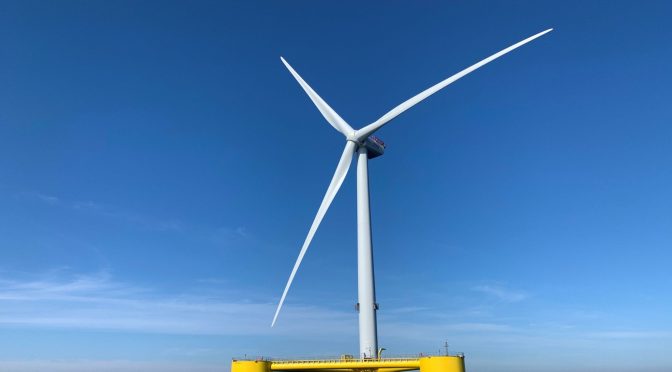If the Government wants to meet the 2030 offshore wind targets set in the National Integrated Energy and Climate Plan (PNIEC), the first auction must be launched next year, without further delay. This is the position of Ocean Winds, the joint venture owned 50% by EDP Renovables and Engie.
In a meeting with the press on the occasion of a visit to the WindFloat Atlantic offshore wind project – the first semi-submersible floating park in the world and already four years in operation – the company’s business development director for Spain, Manuel Fernández, considered that, despite the fact that “there is already a path” to promote the country’s commitment to this technology, we are “at the limit” to meet the 2030 targets, set at three gigawatts (GW) of offshore wind. And that “provided there is a tender in 2025.”
This Tuesday, the Council of Ministers approved the Royal Decree, highly demanded by the sector, which regulates the production of electrical energy from renewable sources located at sea, the regulatory framework of reference for developing this type of installation.
Subsequently, another ministerial order will call for the tender, establishing the calendar for the auction and other elements, which may include modifications to the parameters and criteria derived from the public dialogue held between promoters and affected actors.
In this way, Fernández estimated that a “reasonable” period would be for this ministerial order for the call for tender to be published within a period of about six months after the royal decree.
Ocean Winds, a company created in 2020 and based in Madrid, aspires to be “a protagonist in the advancement of floating offshore wind power in Spain,” proclaimed the project director for Spain and José Miguel Moreira Pinheiro, country manager for Southern Europe of the company and director of the WindFloat Atlantic project. “Tomorrow we would have the capacity to design something specific, our own and designed for the coast in particular,” said Fernández.
In this regard, the leaders of the joint venture between EDPR and Engie stressed that for this development of floating offshore wind power as a national commitment to become a reality, it is necessary to have “the will of the central government and the regional governments.”
«Where there is an area permitted for this, a connection to the grid and a willingness of the governments to develop projects, we will be there», he said, although he stressed that «there will not be more projects than those that the Government wants» within those High Potential Zones (Zaper) identified in the Maritime Space Management Plans (POEM)», in reference to the flood of announcements about possible future projects that have been made.
In addition, Fernández assured that what would make the most sense would be to start with a first contest in the Canary Islands, rather than a global one, since there is «an energy and economic reason» for the development of the floating marina.
Later, after the start in island waters, he opted to continue advancing the technology in the waters of communities such as Galicia, Catalonia or Asturias.
Ocean Winds currently has a total of 16 projects in eight countries in its portfolio, accumulating a gross capacity of over 18 GW.
«THE MATURITY OF FLOATING WIND WILL DEMOCRATIZE OFFSHORE»
In this sense, Moreira Pinheiro ventured that floating offshore wind is already a technology that «allows a number of countries to access offshore wind». «With the maturity of floating, offshore will be democratized, he said.
As an example of this, Ocean Winds presents the success of WindFloat Atlantic, a project owned 65.17% by the joint venture and in which Tokyo Gas (21.2%) and Repsol (13.63%) also participate, whose three turbines, with a combined capacity of more than 25 MW, have been supplying energy to the Portuguese national grid since 2020.
Thus, this pioneering project when it was launched already records a total accumulated production of 320 gigawatt hours (GWh), providing energy each year to more than 25,000 homes, also avoiding more than 33,000 tons of CO2 emissions and having created 1,500 direct and indirect jobs.
In addition, during its four years of operation, this floating offshore wind farm has already successfully overcome challenges such as waves up to 20 meters high and extreme wind gusts, the company assures.


